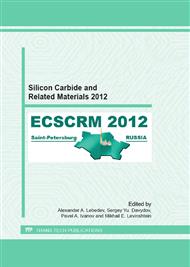p.793
p.797
p.801
p.805
p.809
p.813
p.817
p.821
p.825
Process Variation Tolerant 4H-SiC Power Devices Utilizing Trench Structures
Abstract:
Silicon carbide (SiC) is one of the most attractive semiconductors for high voltage applications. The breakdown voltage of SiC-based devices highly depends on the variation of the fabrication process including doping of the epilayers and the etching steps. In this paper, we show a way to diminish this variability by employing novel trench structures. The influence of the process variations in terms of doping concentration and etching has been studied and compared with conventional devices. The breakdown voltage variation (ΔVBR) of 450 V and 2100 V is obtained for the ±20% variation of doping concentration of the devices with and without the trench structures, respectively. For ±20% variation in etching steps, the maximum ΔVBR of 380 V is obtained for the device with trench structures in comparison to 1800 V for the conventional structure without trench structures. These results show that the breakdown voltage variation is significantly reduced by utilizing the proposed structure.
Info:
Periodical:
Pages:
809-812
Citation:
Online since:
January 2013
Keywords:
Price:
Сopyright:
© 2013 Trans Tech Publications Ltd. All Rights Reserved
Share:
Citation:


